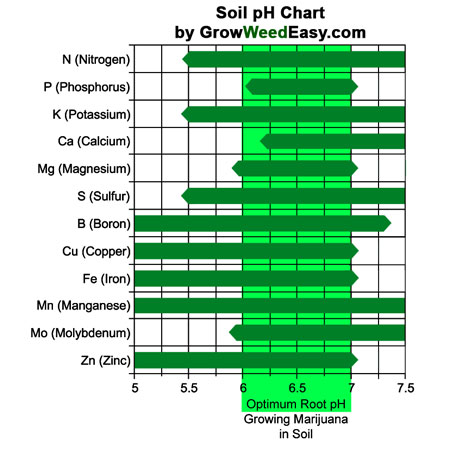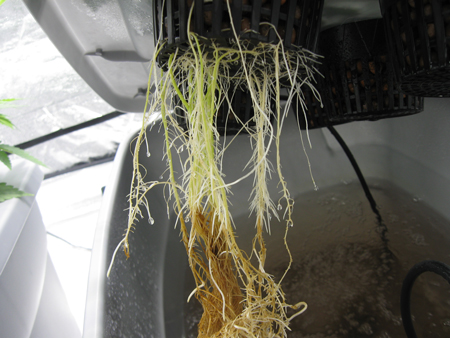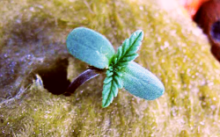You are hereRoots: The Most Important Part of Your Plant!
Roots: The Most Important Part of Your Plant!
 We all know that buds grow on the topside of a cannabis plant. That’s enough reason for many of us to think that the top part of the plant is ‘the important part’.
We all know that buds grow on the topside of a cannabis plant. That’s enough reason for many of us to think that the top part of the plant is ‘the important part’.
But the roots of your plant are the real workforce behind your plants success. They might not be directly responsible for growing buds, but they are responsible for many processes that allow bud growth to happen!
If the buds of a cannabis plant are movie stars (we do seem to admire them and await their arrival), then the roots of your cannabis plant would be all the hard working people behind the scenes who do the editing, cinematography, sound and effects. In fact, a plant with a healthy root system can loose its leaves and recover. But a plant with a healthy leaf system is has no chance if it loses its roots.
Today we’re going to show you how to protect your plants lovely roots, and your plant will pay you back in sticky home-grown bud!
What Roots Do for Your Cannabis Plant
 Roots are the base of your plants wicking system
Roots are the base of your plants wicking system
In a cannabis plant, the path from a root to a leaf is much like a straw. Water is transpired from leaves which creates suction. This helps pull water through the roots, up through the stem and back into leaves. This is a super efficient, low-energy way for plants to get moisture without without having to take in as much water through its leaves. Although the leaves of a cannabis plant can take in water, there are (at least) two important reasons leaves aren’t their main source of water:
- As plants get larger, their demands for hydration simply get too large for the leaves to handle by themselves. Additionally, your plants will need water to form their first leaves, and that water comes from the plants first root!
- The second reason...we’ll get to that in just a second!
Roots Are Needed to Uptake Nutrients
The roots of a cannabis plant are the main site where nutrient uptake occurs. This means that your roots are the gatekeeper for the nutrients your plant gets, and the health of your roots determines how much (if any) of your nutrients are being used.
The leaves of a cannabis plant can also take in nutrients; growers can do this through a method called ‘foliar feeding’, where a nutrient solution is applied directly to the leaves. So why aren’t the leaves the primary place where nutrient uptake occurs?
- In nature, it’s easier for a plant to find nutrients in the earth than anywhere else.
- The same reason as #2 in the previous paragraph, which is...
The Roots Are the Most Important Part of Your Cannabis Plant
 What is a ‘vital organ’? It’s an organ that’s...vital, meaning that it’s absolutely necessary in order for life to continue for the being it belongs to.
What is a ‘vital organ’? It’s an organ that’s...vital, meaning that it’s absolutely necessary in order for life to continue for the being it belongs to.
To a cannabis plant, the roots are it’s only vital ‘organ’. You can remove everything else, and though it may not return to its former glory, the plant will likely survive and try to re-grow foliage. Conversely, a plant with its roots cut off is no longer a plant, it’s a harvest or a bouquet!
When a cannabis plant isn’t getting enough nutrients, it’s leaves/stems get damaged but the roots are left alone. When a plant gets too much nutrients, the leaves get nutrient burn but the roots are left alone. When a cannabis plant gets overwatered...you guessed it, the leaves/stems are what suffer.
In essence, the leaves of a cannabis plant are used as a first line of defense against less-than-perfect conditions. The leaves can also act like backup systems for a few of the functions roots perform, such as nutrient/water uptake. But since cannabis plants already have a primary method of water/nutrient delivery (that has better protection by being underground), the leaves become expendable in hard times. That makes them the exact opposite of being ‘vital’, unlike the roots!
How to Protect Your Roots:
Most problems that people encounter with the roots of their cannabis plant can be boiled down to one of only a handful of causes. These include:
Rootbound (Not Enough Space for Roots to Grow)
The size of a plant is determined in part by the amount of space the roots have to grow. Once the roots run out of space - known as being ‘rootbound’ - the growth of the plant will grind to a halt unless its conditions change. Although this won’t necessarily degrade the health of the roots directly, the rest of the plant will directly suffer in the form of stunted growth.
What You Can Do: Make sure you’re planning to use an appropriate sized pot for your grow. I know that’s harder than it sounds, but luckily we’ve got all the info you need right here! Also, remember that while your plant is in the vegetative stage, you have the option to replant it in a different container if necessary.
Overwatering or Underwatering (Too Much or Not Enough Water)
Overwatering is the term used to describe when there isn’t enough oxygen at the roots of a plant. This pretty much only happens when there is an excess of water in the medium (not counting DWC), so we call it overwatering.
Underwatering is exactly what is sounds like. Too little water for the plant, and parts start to dry up and fall off.
In both cases, the plant will droop which can make it confusing for those who aren’t familiar with the problem. Luckily, the way to prevent both problems and keep your roots happy is easy: don’t water your medium until it feels dry up to your first knuckle.
What You Can Do: Remember, don’t water the medium until it feels dry up until your first knuckle. After a full grow or two , this becomes second nature and you won’t even have to think about it!
pH (Acidity or Alkalinity)
The pH of the medium (soil/coco coir/water) your roots are resting in determines what nutrients they can uptake at that time. For example: if you’re growing hydroponically and the pH of your medium is 5.0, your plant will be unable to uptake calcium even if the water is loaded with it.
The range of pH in which nutrients become available is pretty small; only a 1.0 variance for the entire acceptable range. In soil, this range is 6.0 - 7.0, while in hydroponics it’s 5.5 - 6.5. That being said, it’s still best to avoid getting close to the minimum or maximum for either of those two ranges. The charts below illustrate the pH needed for specific nutrients to become available.
What You Can Do: If you’re using properly amended soil, you’re most likely good to go. Everyone else should make a point to check the pH of their root zone often to ensure proper nutrient uptake. Bad pH equates to bad nutrient uptake which equates to damaged-looking leaves.
Root Rot (Pythium)
Although Root Rot is a larger problem for hydroponic growers (such as those doing Hempy Buckets or DWC), it can affect any grow where the roots are sitting in stagnating water. This is less likely to happen in outdoor grows in soil since water can go further underground.
Root Rot is especially dangerous because it kills the roots first. In some cases, a cannabis plant can look totally fine until the roots have been totally demolished. Luckily, Root Rot has a tell-tale smell that is absolutely awful. Checking for this smell only takes a second, and it can help you ensure you won’t get surprised by a plant that’s suddenly dying! Of course, this check should be paired with preventive measures (i.e., beneficial organisms) so you’re not just waiting for a problem to show up.
What You Can Do: A proper watering regimen (only water when medium is dry to the first knuckle) will prevent most root rot issues. Another very good idea is to add beneficial organisms to your root zone. This way, if pythium does show up, it will quickly be outcompeted by the resident organisms. I suggest Hydroguard as such a product, but Subculture and Great White have also personally given me good results.
Fungus Gnats
 Of all the pests that can infest a cannabis plant, the Fungus Gnat isn’t the worst. However, they’re uniquely annoying in that they infest your medium and directly attack the roots of your plant. A fungus gnat infestation is actually a sign of a different problem: overwatered topsoil!
Of all the pests that can infest a cannabis plant, the Fungus Gnat isn’t the worst. However, they’re uniquely annoying in that they infest your medium and directly attack the roots of your plant. A fungus gnat infestation is actually a sign of a different problem: overwatered topsoil!
Fungus Gnats need a wet environment to be able to successfully reproduce. Although there are products like diatomaceous earth that directly attack the gnats, making sure to not overwater the medium will make it so they don’t even get the chance. Of course, an especially cautious grower could combine both methods for an even more effective means of getting rid of this pest!
What You Can Do: I hate to say it again, but this is another problem that doesn’t exist unless you overwater. Fungus Gnats need water to procreate, and a semi-dry medium spells their doom. That being said, adding diatomaceous earth as additional protection is completely safe and won’t even let them land to try living with your plants!
Jump to...
What's the Best Pot? Containers Explained
How to pH Cannabis - Best pH for Soil or Hydro






